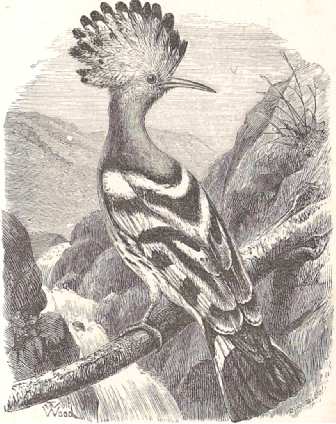|
|
|
The Hoopoe's Appearance
The hoopoe is a peculiarly
conspicuous bird, not only on account of its boldly-barred plumage and its
beautiful crest, but by its cry and its gestures. It has a way of elevating
and depressing its crest, and bobbing its head up and down, in a manner
which could not fail to attract the attention even of the most incurious,
the whole aspect and expression of the bird varying with the raising and
depressing of the crest.
About the size of
a Thrush, with a long, pointed, and slightly arched bill, its head and
neck are a golden-buff color, the head being adorned by the crest, which begins
to rise from the forehead. The crest itself consists of broad feathers, gradually increasing
in length, tipped with black, and having a subterminal bar of yellowish-white.
The upper part of the back is a wine-grey color, and the scapulars and flight-feathers
are black, broadly barred with white, tinged in the former with buff. The
tail is black with a white chevron, marking off about the distal
third part of its length. The legs and feet are as adapted well for running
or walking, as well as for perching. The scutellations are continued round the
whole of the tarsi.
|

Hoopoe Perching above a River
|
Nest and Habits of the
Hoopoe
Pleasing as is the beauty
of this bird as it fearlessly parades its showy plumage, its habits are very
much the opposite. The hoopoe (scientific name Upupa epops) has always had
rather an ill reputation, and, whether in Europe or Asia, its presence
seems to be regarded by the ignorant with a kind of superstitious aversion.
This seemingly universal distaste for the Hoopoe is probably caused by
an exceedingly pungent and disagreeable odour which fills the nest of the
bird, and which can be passed for a considerable time to anyone's hand
if they touch the bird's eggs.
Where it breeds,
its nest, usually in the hollow of a tree or of a wall, (and having therefore
little of the thorough ventillation which is found in nearly all nests
which are built on boughs and sprays), is not only partly composed of quite
foul material, but its condition becomes worse as incubation proceeds.
In many areas, however, hollow trees cannot be found, and
in that case the Hoopoe resorts to clefts in the rock, or even to holes
in old ruins. The hen hardly ever leaves her eggs, being diligently
fed by the cock as she sits; and when the young birds are hatched, their faeces
are not removed by their parents (this was denied by Naumann, but this statement has been confirmed by many eye-witnesses) as is the case
with most birds, but are disposed of in the immediate neighbourhood of the
nest, the unsanitary condition of which is easily imaginable.
A significant part
of the odour however comes from a substance secreted from the tail-glands
of the Hoopoe, and is not due, as was long supposed, to the food which
was brought to the nest.
|
|
|





